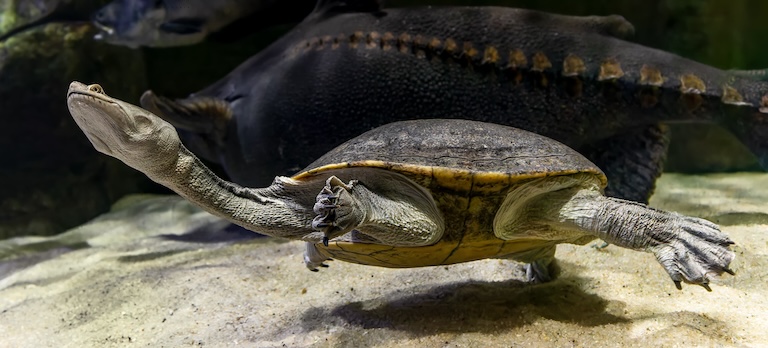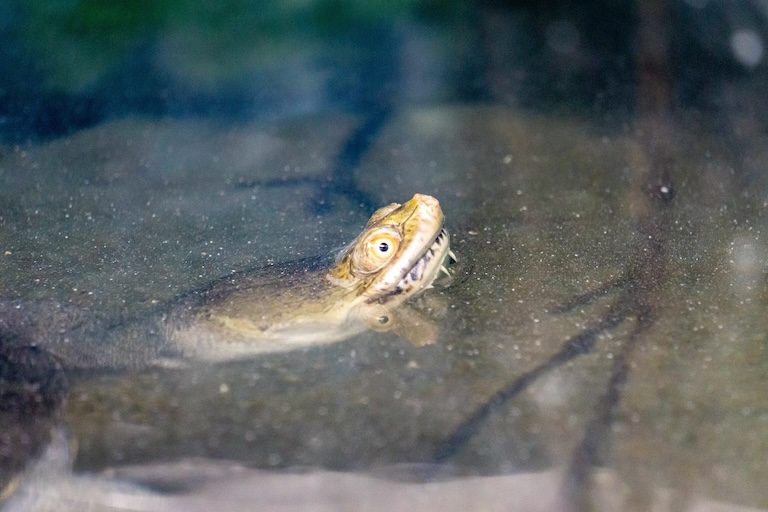Oblong Turtle Profile
Turtles are an interesting bunch. The common ancestors of all modern versions show up in the fossil record from what is now Brazil, dating to the upper Jurassic or early Cretaceous, and while most became sea turtles, some of those became land turtles (tortoises).
And another group entirely restricted themselves to the freshwater ecosystems. Now, we have two branches: the land and sea turtles make up the vast majority, and the freshwater side-necked turtles a tiny relic from an ancient divergence.
Among these, there’s a particularly vocal side-necked turtle turtle from Australia: The Oblong turtle.

Oblong Turtle Facts Overview
| Habitat: | Marshland, swamp, rivers, lakes |
| Location: | Southwestern Western Australia |
| Lifespan: | 80+ years |
| Size: | Around 40cm long |
| Weight: | Up to 2 kg |
| Colour: | Dark brown to black |
| Diet: | Fish |
| Predators: | Ravens, kookaburras, dogs, cats and foxes |
| Top Speed: | Slow, but fast to strike |
| No. of Species: | 1 |
| Conservation Status: | Near Threatened (IUCN) |
Oblong turtles are members of the side-necked turtles and ones who take it to the extreme. Their snake-like necks are used for hunting and are far too long to be retracted, so they wrap them around themselves instead.
As it happens, this is a very old strategy and one that is now relatively rare among turtles. But it works for the oblong, and their shells are adapted to handle it accordingly.
These strange fish-eaters are formidable hunters with a lot to say, and while not quite threatened with extinction, shifts in temperatures and invasive species might start shifting their conservation status in the near future
Interesting Oblong Turtle Facts
1. They’re ancient
Oblong turtles are Chelids, which make up one of three living families of the suborder Pleurodira.
Despite swimming around very similar to their marine (and freshwater) cousins, these are an entirely separate lineage of turtle that branched off from all other familiar examples (Leatherbacks, loggerheads, terrapins, tortoises, etc) when South America was still physically connected to Africa and Australasia.

2. They’ve reduced in diversity since then
Since then, the most common branch, Cryptodira has diversified into what are now 266 species of Cryptodira, in 80 genera and 23 families. The Pleurodira group is humbler: there are three families, 19 genera, and around 90 species.
But it wasn’t always this way! While they’re now exclusively freshwater or slightly brackish turtles, their history was filled with a lot more diversity, including marine species, and various feeding strategies, as opposed to the furiously piscivorous methods we see today.
For example, the largest turtle to have ever lived was a side-necked turtle, owning the swamp, 10 million years ago.
17 or so of these species are in the genus Chelodina, known as the snake-necked turtles, and these are native to Australia, New Guinea, and East Timor. The oblong turtle has a very humble native range, occupying a tiny spot in the southwestern part of Western Australia. 1
3. They’re snake-necked turtles
As members of the Pleurodira suborder, these are side-necked turtles. Turtles in the other group are well known for retracting their necks into their shells, but side-necked turtle necks are so long, that this is impossible.
So instead, they fold it over and sort of wrap it carefully under the lip of the shell when threatened. This gives them a resting sideneck face, which is where the name comes from.
And as members of the Chelodina genus, they have particularly long necks, which gives them the common name, snake-necked turtles.
But there’s more than just a visual similarity here; the neck has adapted to strike at prey, just like a snake would, so it functions as a hunting strategy and not just a cartoonish novelty.
Having such long necks screw with the prey’s understanding of distance. They think they’re looking at a turtle that’s comfortably out of snapping distance, and then BOOM! Out comes the powerful beak, well into their personal space.
4. This creates tension
Such a forceful ejection brings with it counterforces within the turtle that need to be dampened.
Because it’s coming at an angle, rather than straight out, this rapid extension produces a twisting force, or torsion inside the body, which leads to one of the adaptations that sets these turtles apart from their more popular cousins.
Shell morphology is one key way to tell this suborder apart, and within this family, there are several reinforcements within the carapace that have evolved to counter some of the twisting forces. These buttresses are not present in turtles with short necks as they’re not needed.
These buttresses (or lack thereof) are also great for determining details about partial fossils and identifying evolutionary lineages from them. 2
5. They talk a lot
Perhaps to reduce some of the tension, these turtles are unusually chatty.
For the most part, Testudines are thought to be relatively mute – let’s ignore the uncomfortable mating grunts of a male tortoise – and as predominantly solitary animals don’t have a lot of use for their voices, but oblong turtles have a surprisingly rich vocal repertoire.
“Clacks, clicks, squawks, hoots, short chirps, high short chirps, medium chirps, long chirps, high calls, cries or wails, hooos, grunts, growls, blow bursts, staccatos, a wild howl, and drum rolling”, are all examples from the primary literature produced by researchers who studied this.
Mating season noises were different, which suggests they are indeed communicating between themselves, but precisely what they’re saying isn’t clear yet. 3
6. They may also use echolocation
Another use for subaquatic noise is navigation. We see this in many animals such as bats and dolphins, who use the echo of their emitted shouts to form a 3D image of their environments.
Certainly in the murky waters that this turtle inhabits it could come in handy for hunting.
7. They help with mosquitos
Of course, these large predators aren’t born big, they have to start somewhere. Females can lay up to three clutches during the nesting season.
Each clutch ranges from 3 -15 eggs, which are incubated for up to 7 months, depending on weather conditions. What comes out is a mini turtle hatchling of around 3cm long.
As new-born oblongs, most fish are a little bit of a mouthful, so they feed on smaller invertebrates, such as mosquito larvae and tadpoles. 4

8. Temperature is important
This long incubation period is the upper end of a range that spans from around 7-8 months in general. Temperatures are the major factor in how long this takes, and it also affects the sex of the hatchlings.
Increasing temperatures from climate change are affecting reptiles in this way across the world, and while this species is only listed as “Near threatened” by the IUCN, plenty of others are Endangered or even Critically Endangered, and may be setting the trend for species like the oblong.
With temperature-dependent sex determination, there are two types: Pattern 1 involves a single transition zone, in which either males or females are produced above or below a certain temperature threshold.
Pattern 2 has two transition zones, in which females are produced in higher numbers at the extremes and males are abundant between them.
In some species, these ratios are switched: males will become more abundant in extreme temperatures. In oblongs, however, females are more prevalent at higher temperatures, perhaps explaining why they have been slower to struggle than some similar species.
Oblong Turtle Fact-File Summary
Scientific Classification
| Kingdom: | Animalia |
| Phylum: | Chordata |
| Class: | Reptilia |
| Order: | Testudines |
| Family: | Chelidae |
| Genus: | Chelodina |
| Species: | C.oblonga |
Fact Sources & References
- (2018), “History of side-necked turtle diversification revealed”, Agencia Fapesp.
- Marcos Jannello (2017), “Linderochelys rinconensis (Testudines: Pan-Chelidae) from the Upper Cretaceous of northern Patagonia: New insights from shell bone histology, morphology and diagenetic implications”, Research Gate.
- Jacqueline C. Giles (2009), “Voice of the turtle: The underwater acoustic repertoire of the long-necked freshwater turtle, Chelodina oblonga”, The Journal of the Acoustical Society in America.
- “Oblong Turtle”, Climate Watch.
